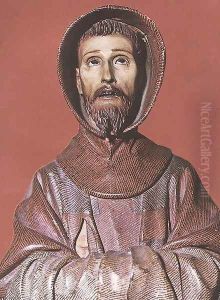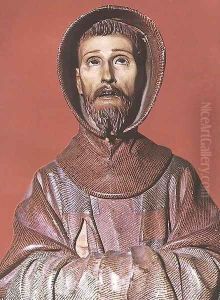Pedro de Mena Paintings
Pedro de Mena y Medrano was a Spanish sculptor, renowned for his work in wood carving, particularly religious figures, and considered one of the most important Baroque artists of the 17th century in Spain. Born in Granada in 1628, Mena was deeply influenced by the intense religiosity of the Counter-Reformation period, which is vividly reflected in his works. He apprenticed under his father, Alonso de Mena, also a sculptor, which laid the foundation for his exceptional skills in wood carving.
Mena moved to Málaga around 1658, where he established his workshop and produced many of his masterpieces. His sculptures are celebrated for their dramatic realism, intricate detail, and emotional depth, qualities that made him highly sought after by religious institutions. Mena's figures often portrayed saints and biblical figures, imbued with a sense of piety and devotion, aiming to evoke a spiritual response from the viewer.
Throughout his career, Pedro de Mena demonstrated a masterful grasp of human anatomy and the drapery of clothes, achieving a level of realism and expressiveness that was unparalleled at the time. His works were not only popular in Spain but also garnered attention and demand from other parts of Europe, testament to his skill and creativity.
Mena's legacy is preserved in various churches and museums, where his sculptures continue to be admired for their beauty and emotional power. He died in Málaga in 1688, leaving behind a body of work that has had a lasting impact on the development of Baroque sculpture in Spain. His dedication to his craft and his ability to convey profound religious experiences through wood carving make him a pivotal figure in the history of Spanish art.

